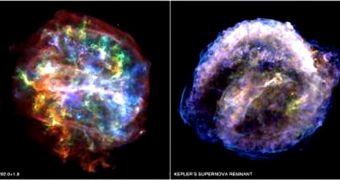When a massive star reaches the end of its burning cycle, it becomes unable to sustain nuclear fusion all on its own, and also exhausts all of its hydrogen fuel. When this happens, the object sheds the outer layers of its atmosphere, all the way to the core, in a violent explosion called a supernova. Classifying the type of explosions that lead to certain types of remnants has been very difficult until now, but a new proposal holds that the classification process could be made easier and faster.
Astrophysicists at the University of California in Santa Cruz (UCSC), led by expert Laura Lopez, say that the new cataloging process could be based entirely on the shape and symmetry of the supernova remnants, as they are seen through X-ray telescopes. The lack of symmetry is just as clear of an indicator as a perfect symmetry is, the team reveals. It says that the new method is based on psychological studies showing how small children first learn to classify objects, based on their shapes.
“It's almost like the supernova remnants have a 'memory' of the original explosion. This is the first time anyone has systematically compared the shape of these remnants in X-rays in this way,” Lopez says. She and her team analyzed a large number of images and recordings relayed back by the American space agency's Chandra X-ray Observatory to come to this conclusion. At this point, the team leader adds, astronomers classify supernovas in “types,” based on the characteristics they display within the days following the initial explosions.
While this is a fairly good method for new supernovas, the team also wants to be able to determine the type of explosion that led to the creation of older remnants that appeared hundreds to thousands of years ago. The group believes that analyzing the symmetry, or lack thereof, may prove to be a good method of doing just that. “If we can link supernova remnants with the type of explosion, then we can use that information in theoretical models to really help us nail down the details of how the supernovas went off,” UCSC expert Enrico Ramirez-Ruiz adds. He is also a coauthor of the new paper detailing the finds, which appears in the November 20 issue of The Astrophysical Journal Letters.

 14 DAY TRIAL //
14 DAY TRIAL //